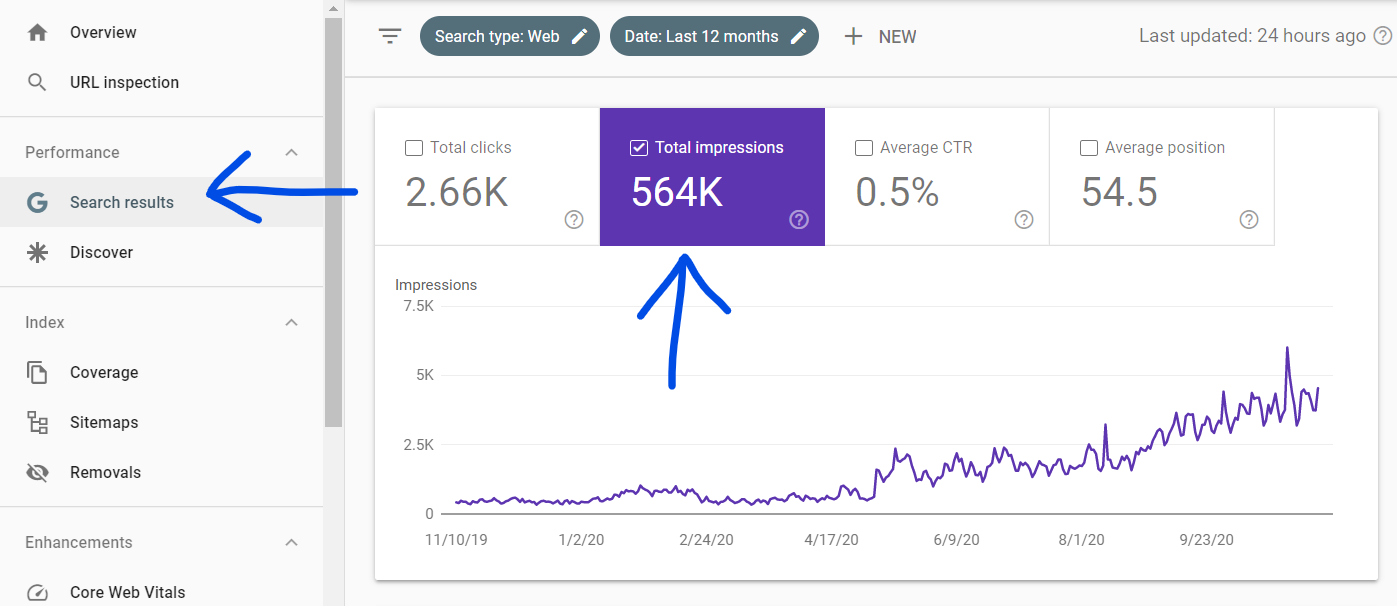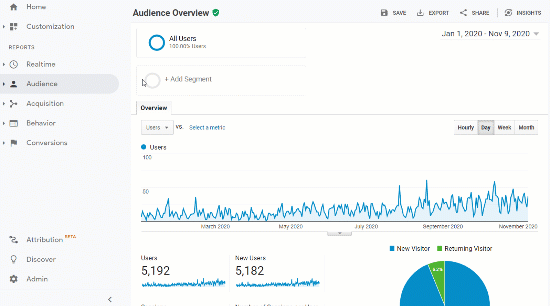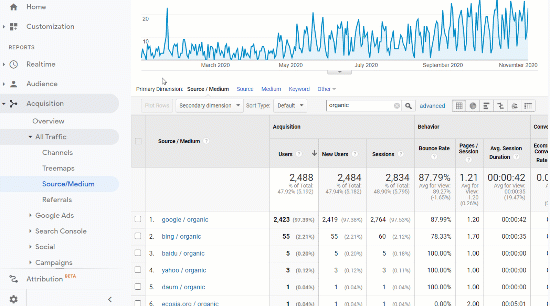When you’re working on growing an organic audience for your website, SEO is a big deal. And when you sit down and create some goals for yourself and your business, you’ll want to include some goals for SEO. But what does that mean? What should you focus on? Here is how to set goals for SEO.
Create Goals that You Can Control
I’m going to start by making this really clear. To set goals for SEO, don’t focus on reaching a target for any particular metric. Instead, set a goal for yourself that you are in complete control as to whether or not it gets completed.
Don’t get me wrong, metrics are important. And it’s important to measure results. But first, let’s create an SEO goal for you.
The most common SEO goal is going to be content related. To be successful with SEO, you need content, you need web pages that are worth ranking. So, decide what type of content you’re going to build out. How often are you going to post? Weekly, bi-weekly, monthly?
This will be your primary SEO goal. Create a goal for how often you will publish new high-quality content on your website so you have pages worth ranking in search engines.
If you focus on creating consistent content, the numbers will improve. You can instead set a goal of improving metrics by a certain amount, but this seems backwards. How will you improve those metrics? Instead, create your goals based on the action you will take to improve your metrics and any improvement you see will only further motivate you to keep improving your website.
Don’t Stop at SEO — Set Goals to Improve Conversion too
Don’t only focus on improving SEO. Getting search traffic is important but it’s only half of the puzzle. Once those people visit your website you want to make sure they convert. If you focus solely on getting search traffic and you don’t work on improving the experience when people visit your site, you’re wasting your time. For SEO to be successful, you need to get people to click on your website, and then your website needs to convert those people.
So, when you’re making goals for SEO, don’t stop at considering how you will grow your organic traffic. Also create a goal to improve your conversion rate. You need to improve CRO in addition to SEO.
To do this, first you need to understand what you want people to do when they access your site. What do you consider a conversion? You likely have multiple conversion paths. Your primary conversion may be for people to make a purchase or register for an account. Before they get to that point, there are likely numerous micro conversions that they are more likely to take on your website. Some of the smaller conversions could be watching a video, downloading a free guide, or signing up for an email course.
Ideally, your micro conversions will exchange a content item for an email. Once someone gives you their email, you then continue the conversation. You offer value, and then more value, and then even more value. Then, you share how your product can help. Then you keep providing value and continue communicating in that manner. Over time, people will become more familiar with your brand and when they’re ready to make a purchase, they will go back to your website.
These are the conversion paths you want to optimize to grow your SEO. The smaller points that take more time to convert to your primary conversion. Someone coming to your website from search likely isn’t going to buy your product today. There is a much better chance they will download the free PDF guide you have available. So start by offering a high value freebie and building trust and authority with your site visitors.
Just like with the SEO goals you created earlier around your content creation, create conversion optimization goals in a similar fashion. Don’t create a goal of improving your conversion rate by a certain percent, instead create a goal you can control.
Do you already have a freebie to get people on your email list? If not, start there. Create a goal to make a conversion path with no barriers to start building trust and authority. If you do already have a freebie, how can it be improved? Is it noticeable on your website? Is it clear what problems it solves and why it’s worth getting? Can the actual item be improved? Do people open the emails you send after the fact or should the subject lines be improved?
Create a goal for yourself to improve the desired conversion path you want people to take after they visit your site from search engines. Once you complete the goal, you’ll be able to monitor conversion rates to see the results and understand the impact of the change. But, set your goal as the action you can perform and use metrics to measure the result.
Optimize Existing Efforts
Getting SEO traffic from new content is great, but don’t forget about the pages on your website that are already bringing you SEO traffic.
Go to Google Analytics, and go to Behavior > Site Content > Landing Pages. Add a secondary dimension of Medium. And then use an advanced search to only include the medium dimension of organic. This will show you the top pages people land on from organic search traffic.

Look at the pages where you get the most sessions. Review those pages. Is the content still accurate? Could you add any charts, images, or videos, to improve the content on the page? Are there any free templates or guides you should offer on this page in exchange for an email address?
Create a goal to review and update the pages that currently bring in the majority of your organic search traffic.
Understand the Metrics to Measure for SEO Results
So now you have at least three SEO goals that you have complete control over if you achieve them or not. You have an SEO content creation goal, a conversion optimization goal, and a goal to improve the current top SEO content. Now, you need to understand the metrics you can measure to determine the impact your goals had on your site performance.
The two main metrics you will monitor are traffic and conversions.
Metrics to Measure Search Traffic
When your website is brand new, your search traffic will probably be very low. And if you just spent months or even a year building content to improve SEO and your traffic numbers are still low, that can be discouraging. Just because your website doesn’t have much traffic yet, doesn’t mean your efforts aren’t having an impact.
When your website is brand new, monitor search impressions instead of traffic. Search impressions will be the first metric that starts to climb when you focus on improving SEO. Your content will start to display more in search engine results pages which increases your impressions. This is positive growth that you should be proud of. Keep going down that path and this will eventually turn into clicks and website visits.
To monitor your search impressions, go to the Google Search Console. Under Performance, click on Search Results. This will show you both the total number of impressions and total clicks. Though clicks will always be much lower than impressions, this will show you if you are trending up or down. So, start by monitoring these impressions when your visitor count is too low to notice an impact.

Once you consistently post content, this will change and your website traffic will increase. The time it takes to start getting search traffic will vary depending on how competitive the industry is and how often you update your website. It could take months or it could take years.
To view the amount of traffic you get from organic search on your website go to Google Analytics. Navigate to Acquisition > All Traffic > Source / Medium. You’ll want to look for your organic traffic sources. This will likely be listed as google / organic and bing / organic. You can view the number of sessions to see how much traffic your site is receiving from search engines. Compare the date range to the previous year to see how your efforts have improved.

Metrics to Measure SEO Conversions
Lastly, you’ll want to measure conversions. In the same Google Analytics report you just looked at to view traffic (Acquisition > All Traffic > Source / Medium) you’ll see on the right hand side there are conversion columns. You can use the dropdown at the top of the conversion columns to select the conversion point you want to measure. This can be e-commerce related or any of the goals you have set up. This will allow you to view the conversion rate and number of completed conversions by the acquisition source such as google organic search traffic.

Sometimes organic search traffic can play a role in the conversion path even though it wasn’t the last piece. For example, someone can find your site using organic search, then they start following you on social media. They eventually convert based on a social media ad which gets credit for the conversion. However, organic search did play a role in the beginning of the process. You can view this information under the Multi-Channel Funnels report. Go to Conversions > Multi-Channel Funnels > Assisted Conversions. Here you can view how the various channels play a role towards conversions.

In Summary
To set goals for SEO, focus on the actions you’re in control of. Set your goals based on what you will get done. Then make sure you know the metrics you can measure to determine the results of your work.
Get the work done, then measure the results. SEO is a long-term game, success doesn’t happen overnight. Stay consistent and be proud of any wins you see.
What SEO goals have you set for yourself? Share them with us in the comments!
Do you want to listen to this article? Here’s the podcast episode:
